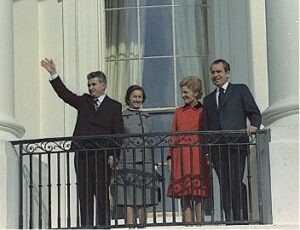
Photo Credits: White House
With the encouragement of the Executive Branch, Chief Justice Earl Warren (1953- 1969) engaged in public diplomacy by officially hosting visiting heads of state at the Supreme Court to promote American constitutional law. Diplomatic efforts continued under Chief Justice Warren E. Burger (1969-1986), but he favored separating the branches. His focus was on hosting foreign dignitaries from the Judicial Branch, inviting them to tour the Court, meet the Justices, and occasionally arranging receptions for them.
Due to unusual circumstances, however, in 1973 the State Department called on the Supreme Court to help with the visit of a head of state. Romanian President Nicolae Ceaușescu was coming to Washington on December 4 to meet with President Richard Nixon and Secretary of State Henry Kissinger for talks on trade and the Middle East: a State dinner was planned for the evening. At the time, Ceaușescu was Washington’s “pet” in the Cold War game as he was critical of the Kremlin and had shown independence from Moscow. Nixon had granted Romania “Most Favored Nation” trade status.
The question was—who would host a luncheon for his wife, Elena Ceaușescu, while her husband was in meetings at the State Department? According to protocol, the task should have fallen to the Second Lady, but Vice President Spiro Agnew had resigned on October 10, facing tax evasion charges. Judy Agnew could not host. Nor could Betty Ford as her husband Gerald Ford would not be sworn in as Vice President until December 6. Next in protocol order was the Secretary of State’s wife, but Henry Kissinger was divorced. So, the State Department asked Vera Burger, the wife of the Chief Justice, to perform this duty as first lady of the judiciary.
The State Department assembled a guest list of 60 women for the “protocol luncheon.” It sent instructions to the Supreme Court’s Public Information Officer, Barrett McGurn, about how to handle press coverage from “Lady Reporters” who were expected to cover the event. McGurn then sent a memo to Chief Justice Burger on November 29 with “foreseeable” queries outlined by the State Department to prepare Vera for the pre- luncheon reception open to the press: “How do you feel about replacing Judy Agnew as the official government hostess? Would you like to do this more often? Will you be sad when Mrs. [Betty] Ford takes over this function-or when Henry [Kissinger] marries again? Do you think Protocol should be rearranged so that the wife of the Chief Justice routinely has her share of these receptions even when there are Wives of the Vice President and Secretary of State? Is Judy Agnew your friend?…Do you plan to carry on her relationship with her?”
Attendees dined on pheasant and artichokes with wild peas in the East Conference Room. In addition to wives of the Romanian embassy staff, wives of Cabinet members, heads of corporations, State Department officials, agency officials, and members of Congress were invited. All the wives of Supreme Court Associate Justices–with the exception of Marjorie Brennan–were in attendance to welcome Madame Ceaușescu. (Martha W. Griffiths (D-MI), Mary Brooks, Director of the Mint, and Helen Bentley of the Federal Maritime Commission attended in their own right, not representing their husbands).
The paths of the two American and Romanian “first ladies” diverged after the luncheon. Vera Burger developed a taste for diplomacy, both public and private. She became active in the International Neighbors Club, a non-profit group that welcomed diplomat families to Washington. At the Court, she answered the State Department’s call for protocol luncheons a few more times. In 1974 and 1975 she hosted Vittoria Michitto, wife of Italian President Giovanni Leone; Stanislawa Jedrusik, wife of First Secretary of Poland Edward Gierek; and Assia Ben Hmida, wife of Prime Minister of Tunisia Hedi Nouira. Elena Ceaușescu returned to Washington several times, but not to the Supreme Court. In 1989 she and her husband would be executed by their people, having plundered their country’s resources and been condemned as brutal tyrants.




